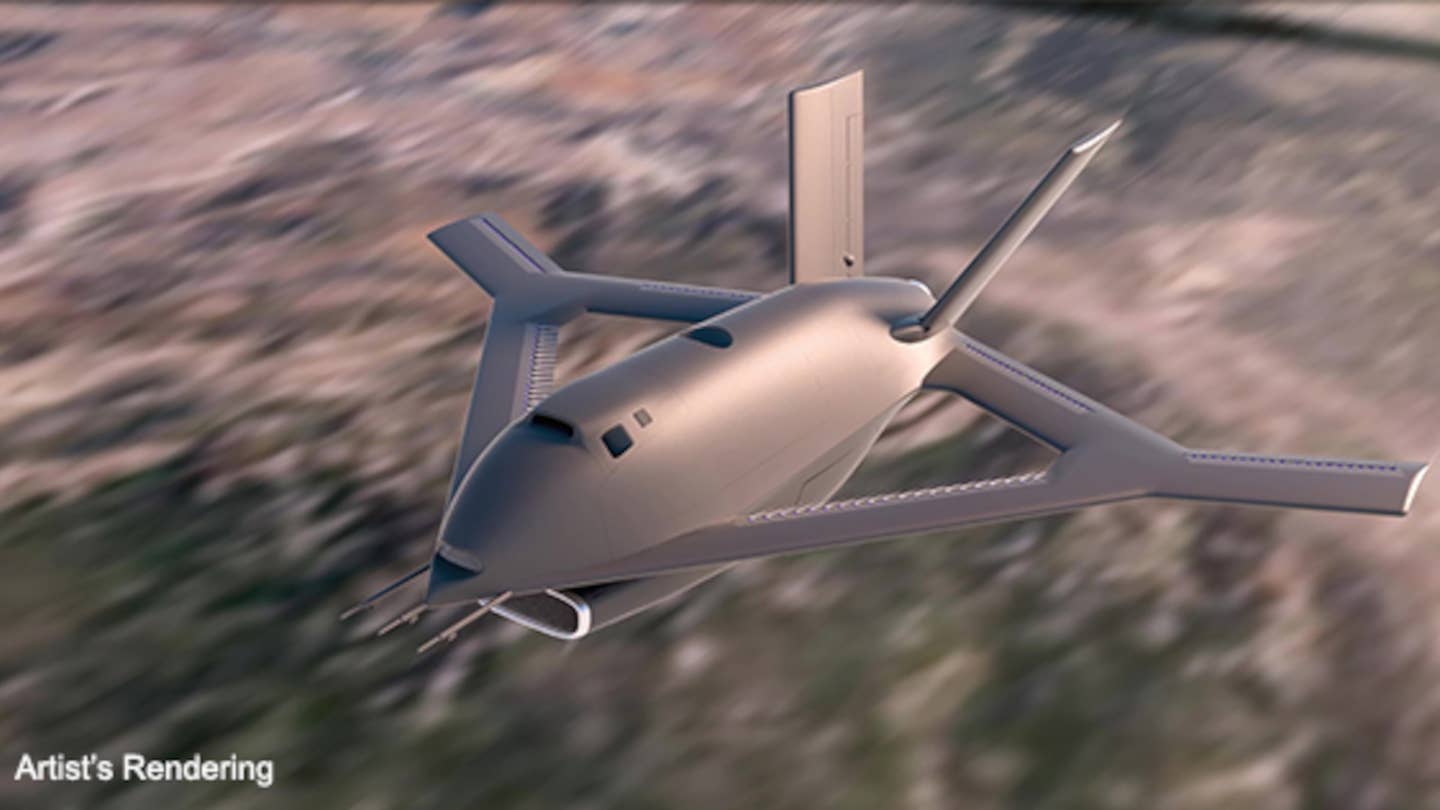Boeing Subsidiary Building Airplane with No Traditional Control Surfaces for U.S. Government
DARPA tapped Aurora Flight Sciences to build the X-65, a full-scale, experimental aircraft design without movable external flight controls.

An artist’s rendering of the X-65 design being developed by Aurora Flight Sciences for DARPA and the CRANE project. [Courtesy: DARPA]
Since the Wright brothers’ first flight more than a century ago introduced wing warping, almost every aircraft manufactured has included adjustable, external control surfaces: whether they be flaps, slats, spoilers, stabilizers, rudders, elevators, ailerons, or some combination of these.
The Defense Advanced Research Project Agency (DARPA), a U.S. Department of Defense unit tasked with developing cutting-edge defense technology, wants to do away with all of them.
DARPA this week selected Aurora Flight Sciences—a research subsidiary of Boeing specializing in the development of uncrewed aerial vehicles (UAVs) and other novel aircraft systems—to build a full-scale demonstrator aircraft that can fly with no surface-level control surfaces.
The project is part of a DARPA program called CRANE, or Control of Revolutionary Aircraft with Novel Effectors. CRANE aims to design, build, and fly an airplane with active flow control (AFC)—in lieu of control surfaces—as a key design consideration. According to DARPA, AFC technology has been explored at the component level but not as a core piece of aircraft design.
Aurora has already begun building the outlandish demonstrator, called the X-65, DARPA said Wednesday. The agency expects it to roll out in early 2025, with the first flight planned for that summer.
No Control Surfaces, No Problem
The smooth-bodied X-65’s wings look almost like mirrored Dyson fans, with large gaps separating them from the body. In fact, the aircraft uses AFC to generate force in a similar way.
For primary flight control, flaps and rudders are replaced by AFC actuators. Much like a Dyson fan, AFC technology produces jets of pressured air, shaping flows over the airplane’s surface. Effectors spread across the surface use those flows to control pitch, roll, and yaw.
“[The X-65’s] distinctive, diamond-like wing shape is designed to help us maximize what we can learn about AFC in full-scale, real-world tests,” said Dr. Richard Wlezien, program manager for CRANE.
DARPA expects the elimination of external moving parts to reduce aircraft weight and complexity, thereby improving performance. In addition, the tech could enable drag reduction, high angle-of-attack flight, simplified high-lift systems, and thicker wings for better structural stability and fuel capacity, the agency said.
The X-65 will be built initially with two sets of control actuators—traditional flaps and rudders—as well as AFC effectors on all lifting surfaces. In addition to minimizing risk in early flight testing, the control surfaces will serve as a baseline for testing. As the campaign progresses, they will be selectively shut down and replaced by AFC for primary flight control.
“The X-65 conventional surfaces are like training wheels to help us understand how AFC can be used in place of traditional flaps and rudders,” explained Wlezien. “We’ll have sensors in place to monitor how the AFC effectors’ performance compares with traditional control mechanisms, and these data will help us better understand how AFC could revolutionize both military and commercial craft in the future.”
The uncrewed X-65 will have a 30-foot wingspan and is projected to weigh more than 7,000 pounds, capable of reaching Mach 0.7 speed (about 537 mph). Its size, speed, and weight will be similar to military trainer aircraft—which means DARPA could uncover immediate AFC applications for real-world designs.
X-Planes, CRANEs, and Aurora Deals
Construction of the X-65 demonstrator represents Phase 3 of CRANE, the U.S. government’s latest X-plane project.
X-planes are a series of experimental U.S. aircraft and rockets, used mainly to test out new technologies and aerodynamic concepts. The first batch was built by Bell Aircraft Corp. (known today as Bell Textron) in the 1940s and ’50s. Since then, Boeing, Northrop Grumman, Lockheed Martin, Curtiss-Wright, and other manufacturers have produced X-plane designs. The most recent, designated X-66, is a transonic truss-braced wing design being developed by Boeing with support from NASA.
With CRANE, DARPA hopes to optimize AFC systems by using the X-65 to mature the technology and design processes. In addition, former CRANE program manager Dr. Alexander Walan in 2020 suggested the agency may create an AFC technology database, which could be used by future manufacturers to design safe, market-ready aircraft.
CRANE began in 2019, when DARPA requested industry participation in the initiative. For Phase 1, which focused on initial design and system requirements, contracts were handed out to Aurora, Lockheed, BAE Systems, and Georgia Tech Research Corp.
But by the time Phase 2 began in January 2023, only Aurora—which had successfully completed wind tunnel testing using a testbed aircraft equipped with AFC—was still under contract. DARPA has now picked up its option for Phase 3, which will explore how AFC can be incorporated on full-scale aircraft and be relied upon for controlled flight.
It’s unclear whether CRANE will continue beyond Phase 3, which is expected to last several years. However, the X-65 is being designed to outlast it.
“We’re building the X-65 as a modular platform—wing sections and the AFC effectors can easily be swapped out— to allow it to live on as a test asset for DARPA and other agencies, long after CRANE concludes,” said Wlezien.
Like this story? We think you'll also like the Future of FLYING newsletter sent every Thursday afternoon. Sign up now.

Sign-up for newsletters & special offers!
Get the latest FLYING stories & special offers delivered directly to your inbox






